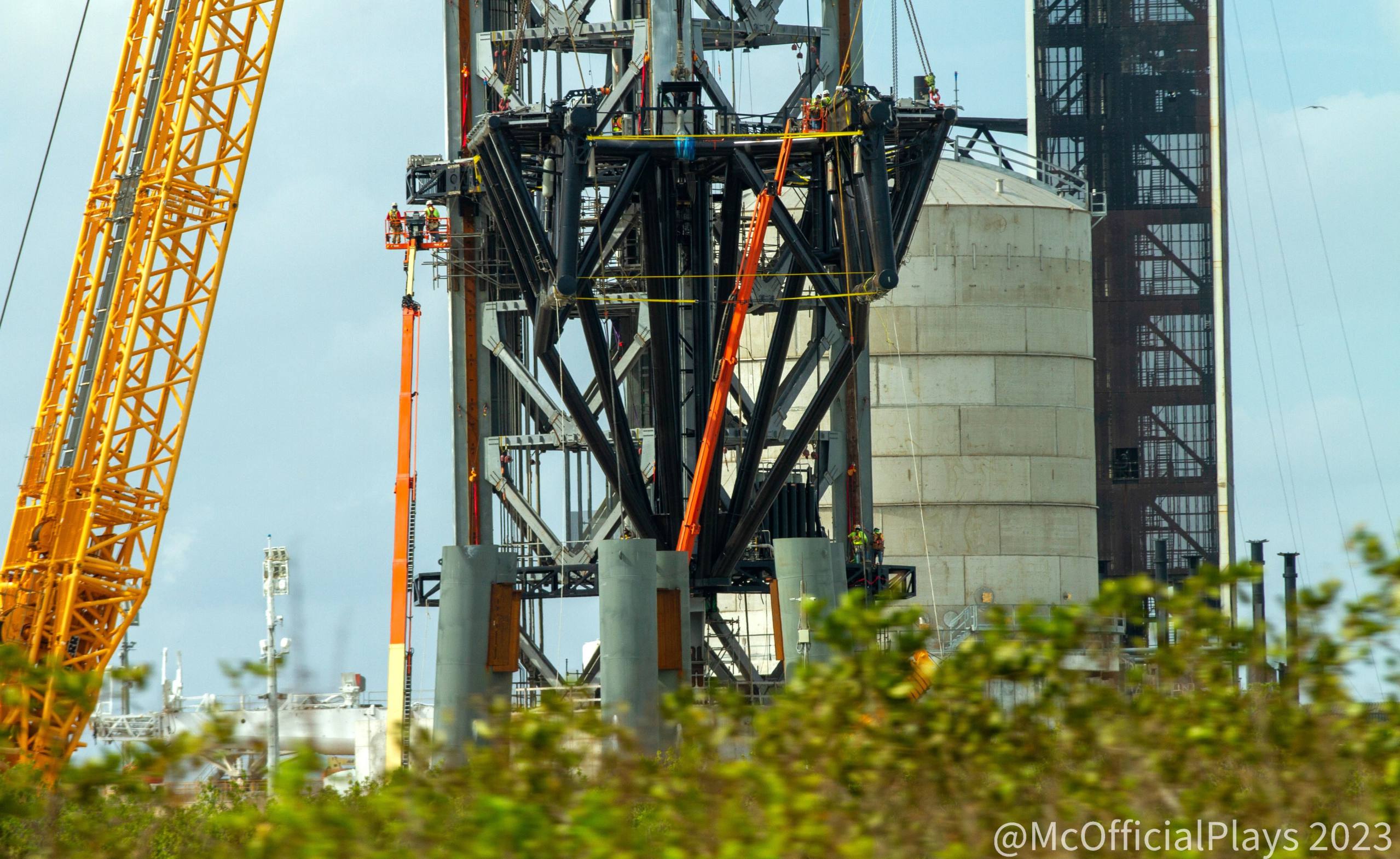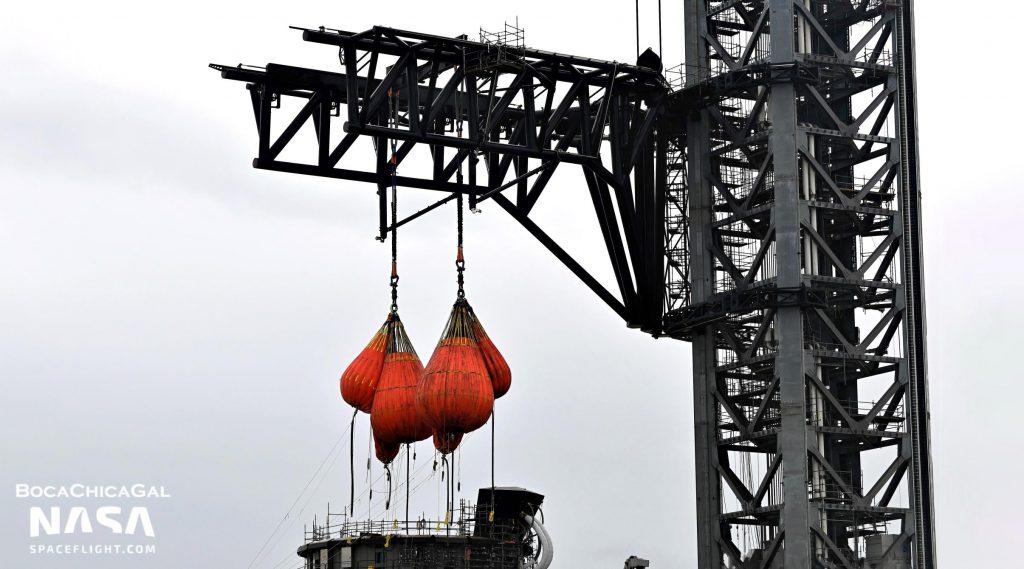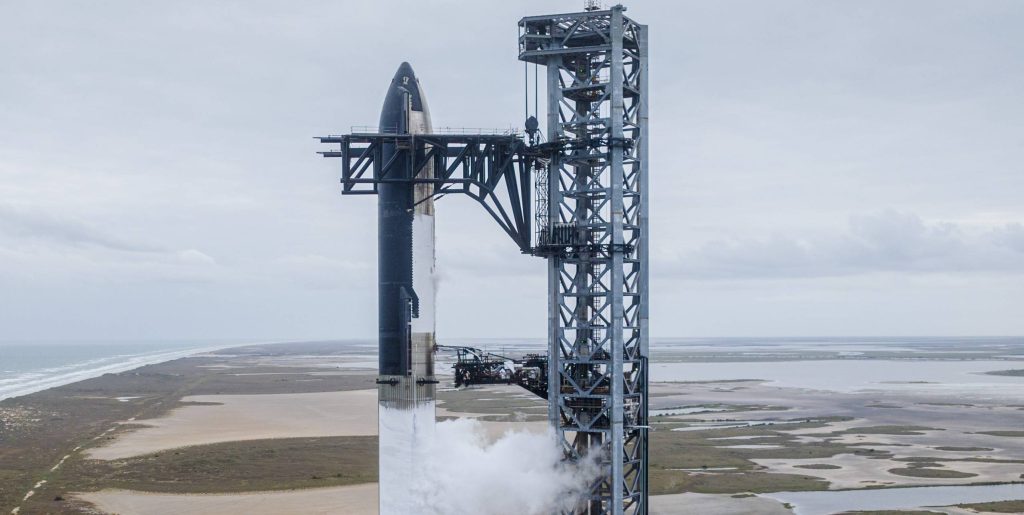

News
SpaceX installs rocket-catching arms on Starship’s Florida launch tower
SpaceX has installed a pair of rocket-catching arms on a tower meant to support the first East Coast launches of its next-generation Starship rocket.
The company has been building the second of several planned Starship launch sites for more than three years. Ironically, work on that pad began before the company started building the pad that will actually support Starship’s first orbital launch attempts. Located a stone’s throw from the Gulf of Mexico in Boca Chica, Texas, the first iteration of SpaceX’s Starbase orbital launch site (OLS) is nearly complete and could host Starship’s orbital launch debut in a matter of months. SpaceX began constructing Starship’s Texas launch site in earnest in late 2020.
SpaceX broke ground on Starship’s first Florida OLS in late 2019. But the company went on to radically redesign the rocket and its ground systems, forcing it to entirely abandon about a year of work by the end of 2020. In late 2021, SpaceX finally began constructing the second iteration of Starship’s first Florida pad. OLS #2 is still colocated at Kennedy Space Center’s LC-39A pad, which SpaceX leases from NASA. Pad 39A is the only site currently capable of launching SpaceX’s Crew Dragon astronaut spacecraft or Falcon Heavy rocket, which has complicated its plans to use the same pad for Starship.
The update that's rolling out to the fleet makes full use of the front and rear steering travel to minimize turning circle. In this case a reduction of 1.6 feet just over the air— Wes (@wmorrill3) April 16, 2024
Because of NASA’s trepidation at the thought of a Starship failure indefinitely delaying SpaceX from completing its Crew Dragon or Falcon Heavy contracts for the agency, the company deprioritized Starship’s Florida pad, slowing progress. SpaceX has, nonetheless, made significant progress. In 13 months, SpaceX has created foundations, modified one of Pad 39A’s giant spherical tanks to store cryogenic methane, installed miles of plumbing, built and assembled a second skyscraper-sized Starship launch tower, installed the legs of the pad’s ‘orbital launch mount’ or OLM, installed a water deluge system at the base of the OLM, assembled most of the OLM’s donut-like mount offsite, constructed a new supersized storage tank, and delivered a forest of smaller storage tanks.
Most recently, SpaceX finished building a giant pair of steel arms, transported the arms to Pad 39A, attached them to a wheeled carriage, and installed the structure on Starship’s Florida launch tower. SpaceX employees have nicknamed the arms “chopsticks,” and those arms are integral to what CEO Elon Musk calls “Mechazilla”. Mechazilla refers to the combined launch tower and arms, which SpaceX has designed to grab, lift, stack, and fuel both stages of Starship.
Mechazilla’s simplest part is a third arm that is vertically fixed in place but capable of swinging left and right. The swing arm contains plumbing and an umbilical device that connects to Starship’s upper stage and supplies propellant, gas, power, and connectivity. The tower’s ‘chopsticks’ are far more complex. Giant hinges connect the pair of arms to a carriage that grabs onto three of the tower’s four legs with a dozen skate-like appendages. Those skates are outfitted with wheels, allowing the carriage to roll up and down tracks built into the tower’s legs.



The carriage, which also carries the complex hydraulic systems that allow its bus-sized arms to move, is connected by steel cable to a heavy-duty “draw works” capable of hoisting the multi-hundred-ton assembly up and down the tower. Once finished, the Florida tower’s arms will be able to precisely lift, maneuver, stack, and de-stack Starship and Super Heavy even in relatively windy conditions. At some point in the future, SpaceX may attempt to use its towers and chopsticks to catch Starships and Super Heavies out of mid-air and speed up reuse.
Set to be the largest, most powerful, and most capable rocket in history, Starship is primarily built out of steel and designed to be fully reusable. SpaceX has a long way to go to demonstrate that the 120-meter-tall (~390 ft) rocket can reach orbit, let alone be reused. In theory, though, Starship is meant to launch up to 150 metric tons (330,000 lb) to low Earth orbit (LEO) while still allowing for the recovery and reuse of its suborbital Super Heavy booster and orbital Starship upper stage.
If SpaceX can achieve those figures, Starship will be the most capable rocket in history even with the major performance penalties that full reusability entails. Saturn V, the most capable rocket ever flown, was fully expendable and could launch up to 118 metric tons (~260,000 lb) into orbit.
Due to NASA’s concerns about the risks that Starship launches from Pad 39A could pose to SpaceX’s Falcon and Dragon operations at the same site, the company’s next-generation rocket may have to wait until 2024 or 2025 for its first Florida launch. With the first Florida Mechazilla now close to completion, it’s likely that Pad 39A’s Starship launch site will be ready and waiting as soon as NASA gives SpaceX the green light.
Elon Musk
Tesla begins expanding Robotaxi access: here’s how you can ride
You can ride in a Tesla Robotaxi by heading to its website and filling out the interest form. The company is hand-picking some of those who have done this to gain access to the fleet.

Tesla has begun expanding Robotaxi access beyond the initial small group it offered rides to in late June, as it launched the driverless platform in Austin, Texas.
The small group of people enjoying the Robotaxi ride-hailing service is now growing, as several Austin-area residents are receiving invitations to test out the platform for themselves.
The first rides took place on June 22, and despite a very small number of very manageable and expected hiccups, Tesla Robotaxi was widely successful with its launch.
Tesla Robotaxi riders tout ‘smooth’ experience in first reviews of driverless service launch
However, Tesla is expanding the availability of the ride-hailing service to those living in Austin and its surrounding areas, hoping to gather more data and provide access to those who will utilize it on a daily basis.
Many of the people Tesla initially invited, including us, are not local to the Austin area.
There are a handful of people who are, but Tesla was evidently looking for more stable data collection, as many of those early invitees headed back to where they live.
The first handful of invitations in the second round of the Robotaxi platform’s Early Access Program are heading out to Austin locals:
I just got a @robotaxi invite! Super excited to go try the service out! pic.twitter.com/n9mN35KKFU
— Ethan McKanna (@ethanmckanna) July 1, 2025
Tesla likely saw an influx of data during the first week, as many traveled far and wide to say they were among the first to test the Robotaxi platform.
Now that the first week and a half of testing is over, Tesla is expanding invites to others. Many of those who have been chosen to gain access to the Robotaxi app and the ride-hailing service state that they simply filled out the interest form on the Robotaxi page of Tesla’s website.
That’s the easiest way you will also gain access, so be sure to fill out that form if you have any interest in riding in Robotaxi.
Tesla will continue to utilize data accumulated from these rides to enable more progress, and eventually, it will lead to even more people being able to hail rides from the driverless platform.
With more success, Tesla will start to phase out some of the Safety Monitors and Supervisors it is using to ensure things run smoothly. CEO Elon Musk said Tesla could start increasing the number of Robotaxis to monitors within the next couple of months.
Elon Musk
Tesla analyst issues stern warning to investors: forget Trump-Musk feud

A Tesla analyst today said that investors should not lose sight of what is truly important in the grand scheme of being a shareholder, and that any near-term drama between CEO Elon Musk and U.S. President Donald Trump should not outshine the progress made by the company.
Gene Munster of Deepwater Management said that Tesla’s progress in autonomy is a much larger influence and a significantly bigger part of the company’s story than any disagreement between political policies.
Munster appeared on CNBC‘s “Closing Bell” yesterday to reiterate this point:
“One thing that is critical for Tesla investors to remember is that what’s going on with the business, with autonomy, the progress that they’re making, albeit early, is much bigger than any feud that is going to happen week-to-week between the President and Elon. So, I understand the reaction, but ultimately, I think that cooler heads will prevail. If they don’t, autonomy is still coming, one way or the other.”
BREAKING: GENE MUNSTER SAYS — $TSLA AUTONOMY IS “MUCH BIGGER” THAN ANY FEUD 👀
He says robotaxis are coming regardless ! pic.twitter.com/ytpPcwUTFy
— TheSonOfWalkley (@TheSonOfWalkley) July 2, 2025
This is a point that other analysts like Dan Ives of Wedbush and Cathie Wood of ARK Invest also made yesterday.
On two occasions over the past month, Musk and President Trump have gotten involved in a very public disagreement over the “Big Beautiful Bill,” which officially passed through the Senate yesterday and is making its way to the House of Representatives.
Musk is upset with the spending in the bill, while President Trump continues to reiterate that the Tesla CEO is only frustrated with the removal of an “EV mandate,” which does not exist federally, nor is it something Musk has expressed any frustration with.
In fact, Musk has pushed back against keeping federal subsidies for EVs, as long as gas and oil subsidies are also removed.
Nevertheless, Ives and Wood both said yesterday that they believe the political hardship between Musk and President Trump will pass because both realize the world is a better place with them on the same team.
Munster’s perspective is that, even though Musk’s feud with President Trump could apply near-term pressure to the stock, the company’s progress in autonomy is an indication that, in the long term, Tesla is set up to succeed.
Tesla launched its Robotaxi platform in Austin on June 22 and is expanding access to more members of the public. Austin residents are now reporting that they have been invited to join the program.
Elon Musk
Tesla surges following better-than-expected delivery report
Tesla saw some positive momentum during trading hours as it reported its deliveries for Q2.

Tesla (NASDAQ: TSLA) surged over four percent on Wednesday morning after the company reported better-than-expected deliveries. It was nearly right on consensus estimations, as Wall Street predicted the company would deliver 385,000 cars in Q2.
Tesla reported that it delivered 384,122 vehicles in Q2. Many, including those inside the Tesla community, were anticipating deliveries in the 340,000 to 360,000 range, while Wall Street seemed to get it just right.
Tesla delivers 384,000 vehicles in Q2 2025, deploys 9.6 GWh in energy storage
Despite Tesla meeting consensus estimations, there were real concerns about what the company would report for Q2.
There were reportedly brief pauses in production at Gigafactory Texas during the quarter and the ramp of the new Model Y configuration across the globe were expected to provide headwinds for the EV maker during the quarter.
At noon on the East Coast, Tesla shares were up about 4.5 percent.
It is expected that Tesla will likely equal the number of deliveries it completed in both of the past two years.
It has hovered at the 1.8 million mark since 2023, and it seems it is right on pace to match that once again. Early last year, Tesla said that annual growth would be “notably lower” than expected due to its development of a new vehicle platform, which will enable more affordable models to be offered to the public.
These cars are expected to be unveiled at some point this year, as Tesla said they were “on track” to be produced in the first half of the year. Tesla has yet to unveil these vehicle designs to the public.
Dan Ives of Wedbush said in a note to investors this morning that the company’s rebound in China in June reflects good things to come, especially given the Model Y and its ramp across the world.
He also said that Musk’s commitment to the company and return from politics played a major role in the company’s performance in Q2:
“If Musk continues to lead and remain in the driver’s seat, we believe Tesla is on a path to an accelerated growth path over the coming years with deliveries expected to ramp in the back-half of 2025 following the Model Y refresh cycle.”
Ives maintained his $500 price target and the ‘Outperform’ rating he held on the stock:
“Tesla’s future is in many ways the brightest it’s ever been in our view given autonomous, FSD, robotics, and many other technology innovations now on the horizon with 90% of the valuation being driven by autonomous and robotics over the coming years but Musk needs to focus on driving Tesla and not putting his political views first. We maintain our OUTPERFORM and $500 PT.”
Moving forward, investors will look to see some gradual growth over the next few quarters. At worst, Tesla should look to match 2023 and 2024 full-year delivery figures, which could be beaten if the automaker can offer those affordable models by the end of the year.
-

 Elon Musk2 days ago
Elon Musk2 days agoTesla investors will be shocked by Jim Cramer’s latest assessment
-

 News1 week ago
News1 week agoTesla Robotaxi’s biggest challenge seems to be this one thing
-

 Elon Musk2 weeks ago
Elon Musk2 weeks agoElon Musk slams Bloomberg’s shocking xAI cash burn claims
-

 News2 weeks ago
News2 weeks agoTexas lawmakers urge Tesla to delay Austin robotaxi launch to September
-

 Elon Musk1 week ago
Elon Musk1 week agoFirst Look at Tesla’s Robotaxi App: features, design, and more
-

 Elon Musk2 weeks ago
Elon Musk2 weeks agoTesla Robotaxis are becoming a common sight on Austin’s public roads
-

 Elon Musk2 weeks ago
Elon Musk2 weeks agoSpaceX President meets India Minister after Starlink approval
-

 Elon Musk2 weeks ago
Elon Musk2 weeks agoxAI’s Grok 3 partners with Oracle Cloud for corporate AI innovation

















